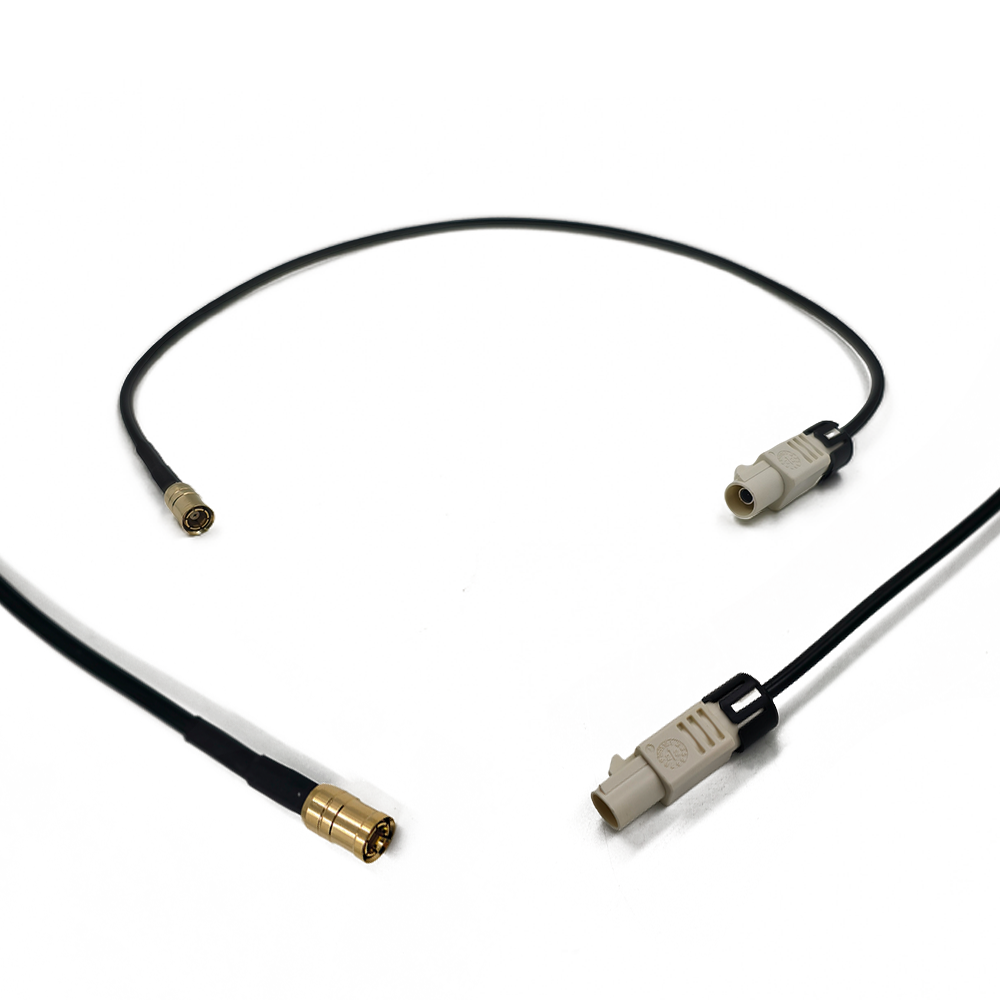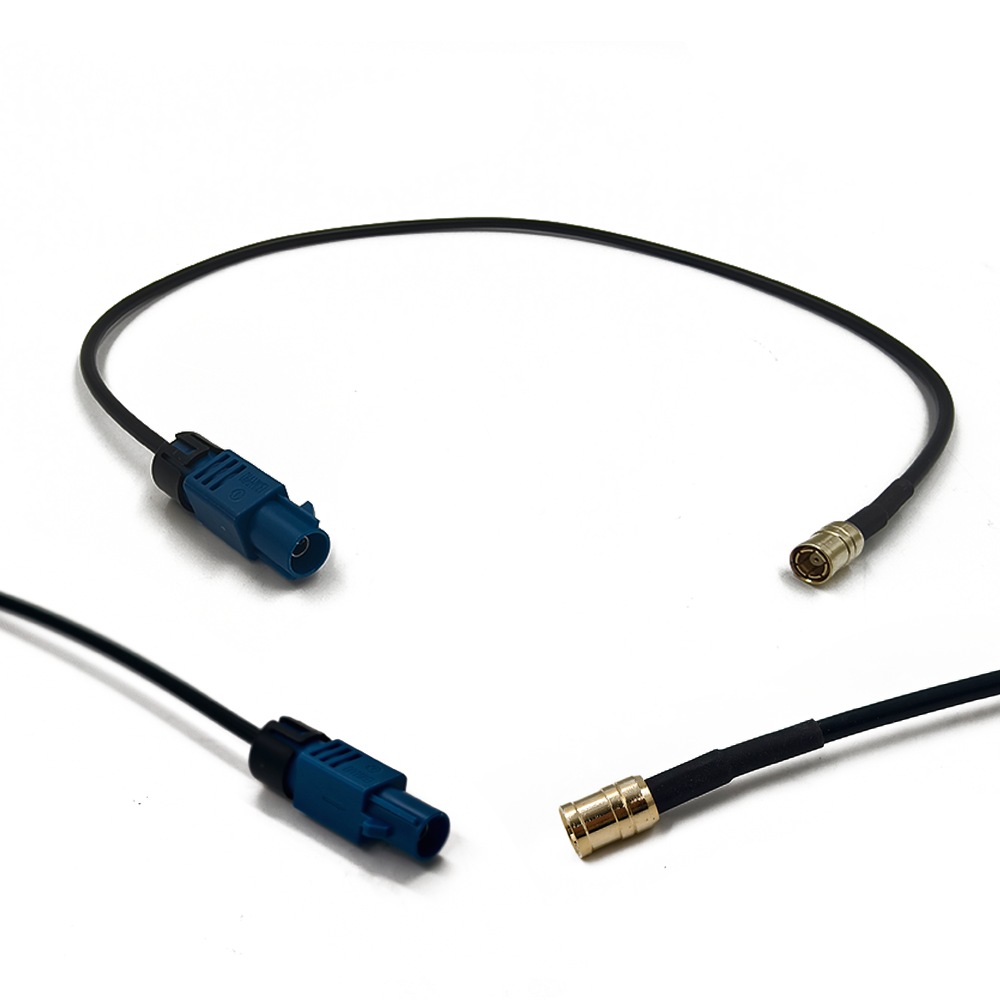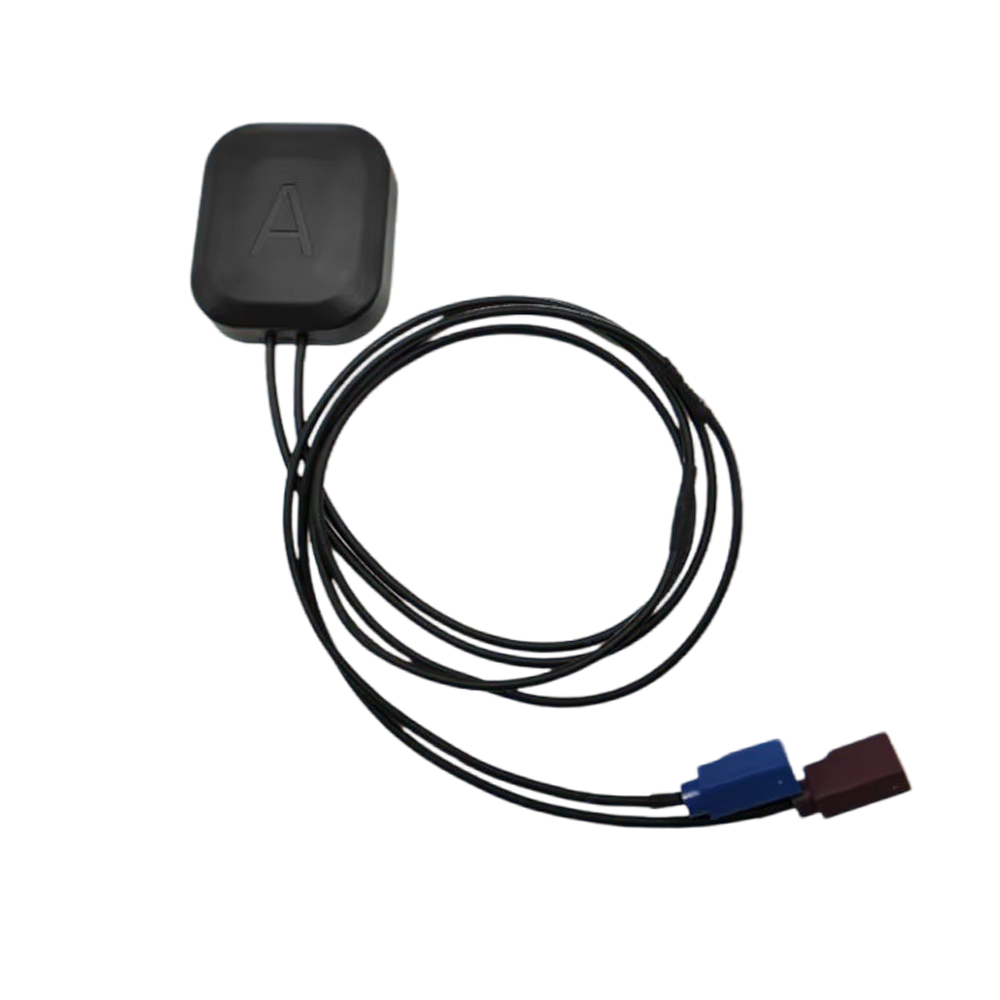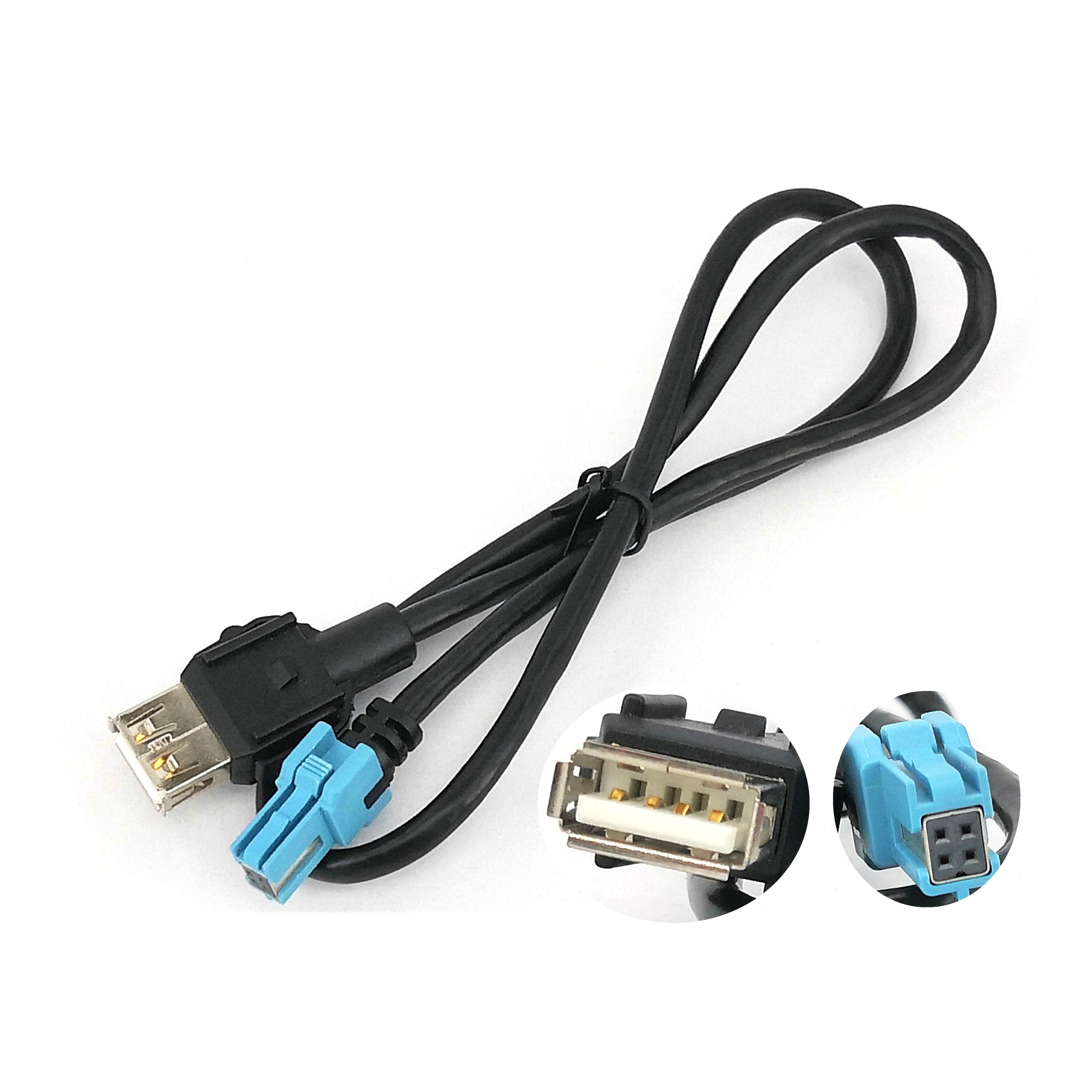Overview
A FAKRA GPS antenna is not defined by a single technology but by a standardized interface system. FAKRA (Fachkreis Automobil, or "Automotive Council") is a German-derived standardization system for automotive antenna connectors and interfaces. A GPS antenna bearing a FAKRA connector is specifically designed for integration into vehicles, guaranteeing mechanical, electrical, and RF compatibility with the vehicle's infotainment or telematics unit. The designation "with strong signal reception" signifies that the antenna incorporates design features—such as a high-gain Low-Noise Amplifier (LNA), high-quality filtering, and an optimized radiator—to overcome the inherent signal-degrading challenges of the automotive environment.
The FAKRA system itself is a masterpiece of design-for-manufacture and reliability. The connectors are color-coded (blue is typically reserved for GPS/GNSS/SDARS applications) and feature a keyed locking mechanism that ensures a secure, waterproof, and vibration-proof connection. This prevents the incorrect mating of cables—a critical feature on a crowded assembly line—and ensures that the connection remains intact over the vehicle's lifespan, despite constant vibration and extreme temperature cycles. This standardization allows automakers to source antennas from multiple suppliers with the confidence that they will plug-and-play with their head units.
The pursuit of "strong signal reception" is what separates a premium FAKRA GPS antenna from a basic one. It implies a focus on several key performance metrics:
High Gain: Significant amplification (often 26-30 dB) to overcome cable losses and ensure a strong signal reaches the receiver.
Low Noise Figure (NF): An LNA that adds minimal internal electronic noise (typically < 1.5 dB), preserving the critical signal-to-noise ratio (SNR) needed to acquire and track weak signals.
Advanced Filtering: Superior bandpass filtering to reject powerful out-of-band interference from in-vehicle systems like cellular modems, Bluetooth transceivers, and engine control units (ECUs).
Multiband Support: While often called "GPS," high-performance units are truly GNSS, capable of receiving signals from multiple constellations (GPS, GLONASS, Galileo, BeiDou) for improved satellite availability and robustness.
These antennas are the unsung heroes of modern mobility. They are hidden within shark-fin housings on vehicle rooftops, integrated into windshields, or discreetly mounted on dashboards, yet they provide the vital location data that enables everything from turn-by-turn navigation and stolen vehicle recovery to advanced driver-assistance systems (ADAS) and autonomous driving functions. They represent the successful marriage of robust automotive-grade engineering with high-performance RF design, creating a standardized solution for one of the most difficult RF environments imaginable.
Design and Construction
The design and construction of a high-performance FAKRA GPS antenna is a complex exercise in balancing electromagnetic efficiency with the uncompromising durability and standardization requirements of the automotive industry. Every component, from the radiator to the connector, is selected and engineered to survive harsh conditions while delivering a strong, clean signal.
The FAKRA Connector: The Heart of Standardization
The defining feature is the FAKRA connector. This is not a simple connector but a sophisticated RF interface system:
Housing and Keying: Made from high-temperature plastic, the housing is color-coded (Blue for GPS/Satellite services) and features a unique mechanical keying system. This keying ensures that only the correct antenna cable can be plugged into the correct port on the head unit, preventing mis-mating during vehicle assembly.
Crimp-and-Snap Mechanism: The center pin connection uses a precise crimp-and-snap mechanism, providing a gas-tight, low-resistance connection that is highly resistant to vibration and corrosion.
Locking Mechanism: A sliding lock or screw-on collar ensures a secure, waterproof (typically IP67-rated), and vibration-proof connection that will not loosen over the vehicle's 15-year lifespan.
Impedance Matching: The entire connector assembly is engineered to maintain a consistent 50-ohm impedance, minimizing signal reflections and ensuring maximum power transfer.
The Antenna Radiator: Capturing Signal in Confined Spaces
The physical element that captures the RF energy is tailored to its placement:
Patch Antennas: Common in external "shark-fin" modules. A ceramic patch antenna offers a good balance of performance and low profile. Its high dielectric constant allows for a smaller size while maintaining resonance at GNSS frequencies.
Planar Inverted-F Antennas (PIFAs): Often used for internal placement (e.g., on dashboards). The PIFA design provides a compact form factor and decent bandwidth, making it suitable for integration into limited spaces.
FPC Antennas: Flexible Printed Circuit (FPC) antennas are used when the antenna must conform to a specific, non-flat surface within the vehicle's interior.
The Low-Noise Amplifier (LNA): The Source of "Strong Signal"
The integrated LNA is the core of "strong signal reception." Its design is paramount:
High Gain: Automotive coaxial cable runs can be long (3-5 meters), introducing significant signal loss. The LNA must provide high gain (26-30 dB is standard) to overcome these losses and deliver a strong signal to the receiver.
Ultra-Low Noise Figure: In an environment already rich with noise, the LNA must be exceptionally "quiet." A low Noise Figure (< 1.5 dB, with premium models < 1.0 dB) is non-negotiable to preserve the Signal-to-Noise Ratio (SNR).
Automotive-Grade Components: The LNA uses components rated for the automotive temperature range (-40°C to +85°C or higher) and capable of withstanding voltage transients and power supply noise common in vehicles.
Filtering: Surviving the RF Jungle of the Automobile
A modern vehicle is an electrically noisy environment. The antenna must include robust filtering:
Bandpass Filters: Surface Acoustic Wave (SAW) filters or Integrated Passive Device (IPD) filters are placed before the LNA. They are designed with a sharp roll-off to aggressively attenuate powerful out-of-band signals from cellular (4G/5G), WiFi, Bluetooth, and key fob receivers, preventing them from overloading the sensitive LNA.
ESD and Surge Protection: Circuits are included to protect the LNA from electrostatic discharge (ESD) during handling and from voltage surges on the power line.
Physical Construction and Durability:
Housing: For external antennas, the housing is made from materials like Polybutylene Terephthalate (PBT) or Polycarbonate (PC), which offer excellent UV resistance, weatherability, and high-temperature performance. The design is often low-profile and aerodynamic.
Cable: The attached coaxial cable is typically a thin, flexible, and durable type like RG-174 or a proprietary equivalent, with a double shield (foil + braid) for excellent EMI immunity. The cable is rated for high temperatures and exposure to automotive fluids.
Sealing and Potting: External modules are hermetically sealed (IP6K9K rating is common for weatherproofness) using silicone gaskets. The internal cavity is often potted with a flexible epoxy or silicone gel to secure components against vibration, provide thermal management, and protect against humidity and condensation.
In summary, the construction of a high-performance FAKRA GPS antenna is a holistic approach that integrates a high-efficiency radiator, a ultra-low-noise amplifier, sophisticated filtering, and a ruggedized, standardized interface into a single package built to survive on the road for over a decade.
Working Principles
The operational principle of a FAKRA GPS antenna with strong signal reception is a continuous process of capture, purification, and amplification, specifically engineered to win the battle against the uniquely challenging RF environment of an automobile.
1. Signal Capture in a Hostile Environment:
The process begins with the antenna radiator (patch or PIFA) converting the incoming, incredibly weak GNSS electromagnetic waves (around -130 dBm) into a tiny electrical current. However, this occurs in a worst-case scenario:
Signal Blocking: If placed inside the vehicle, the metal roof and body panels attenuate signals significantly. Even external antennas must deal with signal nulls caused by the vehicle's structure.
Multipath Interference: Signals reflect off the road, other vehicles, and buildings, creating multiple delayed copies of the same signal that arrive at the antenna and corrupt the precise timing measurements.
2. First Line of Defense: Frequency Filtering
Before the faint signal can be amplified, it must be purified. The received RF spectrum is crowded with high-power transmissions. The integrated bandpass filter (e.g., a SAW filter) acts as a precise gatekeeper. Its transfer function is designed to have very high attenuation outside the GNSS bands (e.g., 1550-1610 MHz). This effectively blocks:
Cellular Signals: Powerful 700 MHz, 800 MHz, 1.8 GHz, 1.9 GHz, and 2.1-2.5 GHz signals from the vehicle's own modem and nearby cell towers.
WiFi/Bluetooth: Energy at 2.4 GHz and 5 GHz.
Other RF Sources: AM/FM broadcast signals, key fob transmissions, and radar emissions.
By removing these overpowering interferers before amplification, the filter prevents the LNA from being driven into compression or generating intermodulation products that would create noise within the GNSS band itself.
3. Critical Low-Noise Amplification:
The now-filtered, but still extremely weak, signal is passed to the Low-Noise Amplifier (LNA). The LNA's job is to boost the amplitude of this signal by a factor of several hundred (e.g., 30 dB of gain is a 1000x voltage increase).
The "Low-Noise" characteristic is what defines a high-performance antenna. All amplifiers generate internal noise due to the random motion of electrons. A premium LNA is designed to add the absolute minimum amount of this thermal noise (quantified by its Noise Figure). By preserving the Signal-to-Noise Ratio (SNR), the amplified signal that emerges is not just stronger, but cleaner relative to the noise floor. This high SNR is the fundamental prerequisite for the receiver to successfully acquire satellites, maintain lock, and track weak signals in urban canyons or under tree cover.
4. Delivery via a Standardized, Lossy Path:
The amplified and clean signal is injected into the coaxial cable. Despite the high gain of the LNA, the long cable run (3-5 meters is typical in a car) still introduces attenuation. The FAKRA connector ensures that this connection is perfect—a 50-ohm impedance match with minimal insertion loss and no signal reflection. Any imperfection here would undo the careful work of the LNA and filter.
5. Receiver Processing:
The signal finally arrives at the GNSS receiver IC within the head unit or telematics module. The receiver can now perform its correlation, tracking, and navigation solution calculations on a signal that is strong enough and has a high enough SNR to be usable, even in challenging conditions. The receiver may also employ advanced algorithms like Assisted-GPS (A-GPS), using data from the cellular modem to further improve acquisition time and sensitivity.
In essence, the FAKRA antenna acts as a dedicated, remote signal pre-conditioner. It doesn't just receive signals; it actively fights the vehicle's environment to recover the GNSS signal, amplify it without adding distortion, and deliver it faithfully to the receiver through a standardized, robust interface. The "strong signal" is not just about raw power; it is about delivering a high-fidelity, high-SNR signal that the receiver can actually use to compute a reliable position.
Advantages and Challenges
-
The adoption of the FAKRA GPS antenna system offers significant advantages for automotive manufacturers and consumers, but it also introduces a set of challenges that must be carefully managed during vehicle design.
Advantages:
Standardization and Interoperability: This is the primary advantage. The FAKRA system provides a plug-and-play ecosystem. Automakers can source antennas from multiple suppliers and receivers from different chipset vendors, confident that they will be mechanically and electrically compatible. This simplifies the supply chain, reduces costs, and prevents assembly line errors.
Proven Reliability and Durability: FAKRA connectors are engineered to meet rigorous automotive standards for vibration, moisture, temperature cycling, and chemical resistance. The crimp-style connection provides a gas-tight interface that is highly resistant to corrosion, ensuring reliable performance over the entire 15+ year lifespan of a vehicle.
Optimized Performance: A well-designed active FAKRA antenna, with its integrated LNA placed right at the feed point, provides a superior solution to passive antennas. By amplifying the signal before it travels through the lossy cable, it delivers a much stronger signal to the receiver than a passive antenna would, directly enabling better performance in weak-signal conditions.
EMI/RFI Immunity: The double-shielded coaxial cable and the robust connector design provide excellent immunity against electromagnetic interference from the vehicle's own systems, preventing noise from corrupting the signal on its journey to the receiver.
Simplified Integration for Aftermarket: The standard also benefits the aftermarket industry. Telematics boxes, fleet tracking devices, and aftermarket navigation systems can be designed with a FAKRA port, allowing for a simple, reliable, and high-performance connection to an external antenna.
Challenges and Considerations:
Cost: A high-quality active FAKRA antenna with a low-noise LNA, advanced filtering, and automotive-grade components is significantly more expensive than a simple passive antenna. The specialized connector and cable also add cost.
System-Level Design Complexity: While the interface is standardized, achieving "strong signal reception" requires careful system-level design:
Power Supply Noise: The LNA is powered through the same coaxial cable (phantom power). Noise on the DC power supply from the vehicle's electrical system can be injected into the LNA and amplified, degrading performance. This requires clean voltage regulation and filtering on the receiver end.
Placement: The antenna's performance is still heavily dependent on its location. An antenna buried deep in a dashboard, surrounded by metal and displays, will perform worse than one in a rooftop shark-fin. The vehicle's design can undermine the antenna's capabilities.
Limited Customization: The FAKRA standard defines the interface, but not the internal performance. An automaker seeking to reduce cost might select a antenna with a higher noise figure or cheaper filter, resulting in poorer performance, even though it still "plugs in."
Cable Loss Management: While the LNA compensates for cable loss, the length and quality of the cable are still critical. Excessively long or low-quality cable will attenuate the amplified signal, negating the benefit of the LNA.
Evolution of Technology: The FAKRA standard, while robust, is a physical connector system. As vehicles move towards more integrated "antenna in glass" solutions and centralized domain controllers with fewer physical connections, the role of discrete FAKRA antennas may evolve.
In summary, the FAKRA system provides an excellent, reliable foundation for automotive connectivity. However, realizing "strong signal reception" requires more than just plugging in a compliant antenna; it demands a holistic vehicle-level approach to RF design, power management, and antenna placement.
Applications and Future Trends
-
FAKRA GPS antennas with strong signal reception are fundamental components in the connected vehicle ecosystem, enabling a wide array of applications that rely on precise, continuous, and reliable location data.
Applications:
In-Vehicle Infotainment (IVI) and Navigation: The most common application. Provides the location data for turn-by-turn navigation, points-of-interest search, and traffic-aware routing.
Telematics and Fleet Management: Hidden within vehicles, these antennas provide the data for tracking vehicle location, monitoring driver behavior (for insurance or safety), optimizing routes, and managing fuel consumption for commercial fleets.
Emergency Services (eCall): Mandated in the EU and other regions, eCall systems automatically dial emergency services in the event of a severe accident and transmit the vehicle's precise location. The reliability of the GPS antenna is a critical life-safety function.
Advanced Driver-Assistance Systems (ADAS): While not the primary sensor for autonomy, GNSS data is crucial for ADAS features like intelligent headlight aiming, adaptive cruise control with curve speed adaptation, and providing context for sensor fusion algorithms (e.g., correlating camera data with a known map location).
Stolen Vehicle Recovery: Aftermarket tracking devices used for stolen vehicle recovery rely on discreet, high-performance FAKRA antennas to provide a continuous location stream to law enforcement, even if the vehicle is parked in a garage or underground lot where signals are weak.
Usage-Based Insurance (UBI): Devices that monitor driving habits and mileage require a dependable location fix to accurately track where and how a vehicle is driven.
Future Trends:
Integration into Multi-Function "Shark Fin" Modules: The standalone GPS antenna is increasingly rare. Instead, the GPS radiator is integrated into a single housing (the shark fin) with antennas for cellular (4G/5G), WiFi, Bluetooth, SDARS (Satellite Radio), and V2X. This presents new challenges for isolating the sensitive GNSS receiver from the powerful transmitted signals of the other radios.
The Rise of GNSS and Multi-Band: The shift from GPS to multi-constellation GNSS (GPS, GLONASS, Galileo, BeiDou) is already standard. The next step is multi-band reception (e.g., L1 + L5). Multi-band allows the receiver to correct for ionospheric delay, dramatically improving accuracy from meters to decimeters. This will be essential for lane-level navigation and will require more advanced antenna designs.
Dead Reckoning Integration: "Strong signal" will increasingly be about continuity, not just absolute accuracy. GNSS antennas will be co-designed with inertial measurement units (IMUs) inside the telematics unit. When the GNSS signal is lost (in tunnels, urban canyons), the IMU takes over, using wheel speed and gyro data to "dead reckon" the vehicle's position until a satellite fix is reacquired.
Enhanced Filtering for V2X and 5G: As Vehicle-to-Everything (V2X) communication and 5G modems become standard, the RF environment will become even noisier. Future antennas will require even more sophisticated filtering to reject interference from these powerful, close-proximity transmitters.
Standard Evolution: The FAKRA standard may evolve or be supplemented by new interfaces like HFM® (High-Speed Data Link) or others that can handle the combined data from multiple integrated antennas, supporting faster data rates for autonomous driving applications.
Conclusion
The FAKRA GPS antenna with strong signal reception is a paradigm of successful engineering standardization. It represents the automotive industry's solution to one of its most persistent challenges: achieving reliable electronic performance in an environment characterized by extreme conditions, intense electronic noise, and complex supply chains. It is far more than a simple connector; it is a complete system that encapsulates high-performance RF design within a rugged, standardized, and reliable package.
Its value lies in its duality. It provides the performance necessary to recover faint satellite signals from within an electrically hostile metal box, and it provides the standardization necessary for efficient, high-volume manufacturing and repair. This combination has made it the undisputed backbone of automotive location services for over a decade, enabling the rollout of critical safety features like eCall and forming the foundation for the connected services that drivers now take for granted.
While the future of automotive electronics points towards greater integration and centralized architectures, the fundamental principles embodied by the high-performance FAKRA antenna will remain relevant. The need for robust RF performance, immunity to interference, and operational reliability will only intensify as vehicles become more connected and autonomous. The FAKRA antenna, in its current form or in an evolved state, will continue to serve as the reliable and robust arbiter of location, ensuring that the vehicle—and all the systems that depend on it—always knows exactly where it is.




































































 Language
Language
 En
En Cn
Cn Korean
Korean

 Home >
Home > 








 18665803017 (Macro)
18665803017 (Macro)













